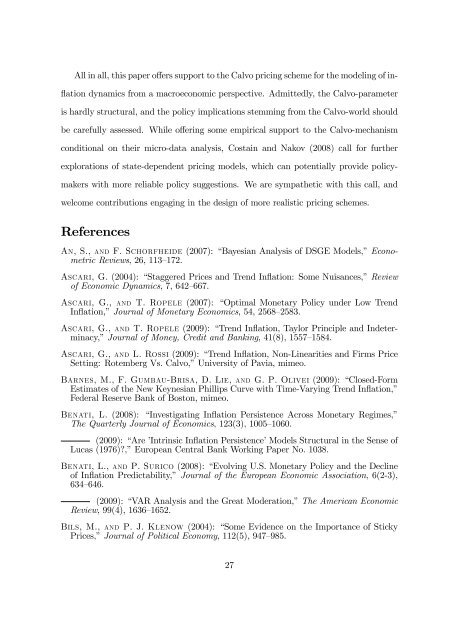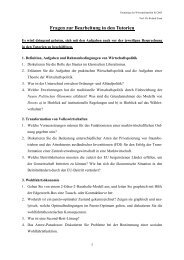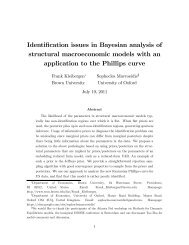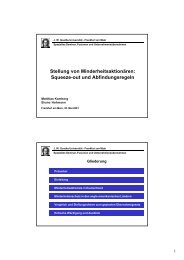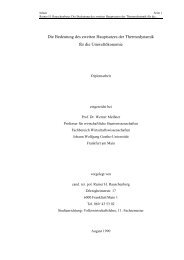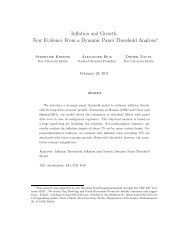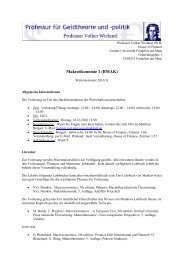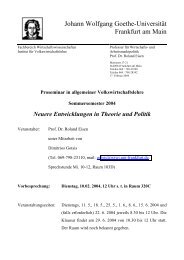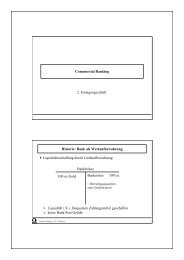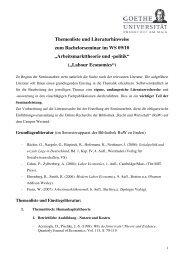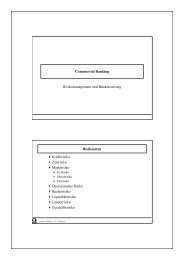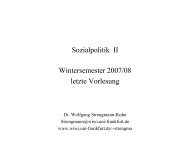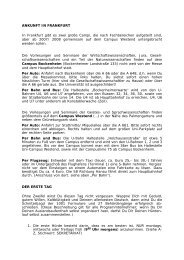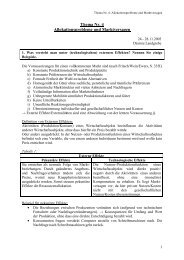Calvo vs. Rotemberg in a Trend Inflation World - Wiwi Uni-Frankfurt
Calvo vs. Rotemberg in a Trend Inflation World - Wiwi Uni-Frankfurt
Calvo vs. Rotemberg in a Trend Inflation World - Wiwi Uni-Frankfurt
Create successful ePaper yourself
Turn your PDF publications into a flip-book with our unique Google optimized e-Paper software.
All <strong>in</strong> all, this paper o¤ers support to the <strong>Calvo</strong> pric<strong>in</strong>g scheme for the model<strong>in</strong>g of <strong>in</strong>-<br />
‡ation dynamics from a macroeconomic perspective. Admittedly, the <strong>Calvo</strong>-parameter<br />
is hardly structural, and the policy implications stemm<strong>in</strong>g from the <strong>Calvo</strong>-world should<br />
be carefully assessed. While o¤er<strong>in</strong>g some empirical support to the <strong>Calvo</strong>-mechanism<br />
conditional on their micro-data analysis, Costa<strong>in</strong> and Nakov (2008) call for further<br />
explorations of state-dependent pric<strong>in</strong>g models, which can potentially provide policy-<br />
makers with more reliable policy suggestions. We are sympathetic with this call, and<br />
welcome contributions engag<strong>in</strong>g <strong>in</strong> the design of more realistic pric<strong>in</strong>g schemes.<br />
References<br />
An, S., and F. Schorfheide (2007): “Bayesian Analysis of DSGE Models,”Econometric<br />
Reviews, 26, 113–172.<br />
Ascari, G. (2004): “Staggered Prices and <strong>Trend</strong> In‡ation: Some Nuisances,”Review<br />
of Economic Dynamics, 7, 642–667.<br />
Ascari, G., and T. Ropele (2007): “Optimal Monetary Policy under Low <strong>Trend</strong><br />
In‡ation,”Journal of Monetary Economics, 54, 2568–2583.<br />
Ascari, G., and T. Ropele (2009): “<strong>Trend</strong> In‡ation, Taylor Pr<strong>in</strong>ciple and Indeterm<strong>in</strong>acy,”Journal<br />
of Money, Credit and Bank<strong>in</strong>g, 41(8), 1557–1584.<br />
Ascari, G., and L. Rossi (2009): “<strong>Trend</strong> In‡ation, Non-L<strong>in</strong>earities and Firms Price<br />
Sett<strong>in</strong>g: <strong>Rotemberg</strong> Vs. <strong>Calvo</strong>,”<strong>Uni</strong>versity of Pavia, mimeo.<br />
Barnes, M., F. Gumbau-Brisa, D. Lie, and G. P. Olivei (2009): “Closed-Form<br />
Estimates of the New Keynesian Phillips Curve with Time-Vary<strong>in</strong>g <strong>Trend</strong> In‡ation,”<br />
Federal Reserve Bank of Boston, mimeo.<br />
Benati, L. (2008): “Investigat<strong>in</strong>g In‡ation Persistence Across Monetary Regimes,”<br />
The Quarterly Journal of Economics, 123(3), 1005–1060.<br />
(2009): “Are ’Intr<strong>in</strong>sic In‡ation Persistence’Models Structural <strong>in</strong> the Sense of<br />
Lucas (1976)?,”European Central Bank Work<strong>in</strong>g Paper No. 1038.<br />
Benati, L., and P. Surico (2008): “Evolv<strong>in</strong>g U.S. Monetary Policy and the Decl<strong>in</strong>e<br />
of In‡ation Predictability,” Journal of the European Economic Association, 6(2-3),<br />
634–646.<br />
(2009): “VAR Analysis and the Great Moderation,”The American Economic<br />
Review, 99(4), 1636–1652.<br />
Bils, M., and P. J. Klenow (2004): “Some Evidence on the Importance of Sticky<br />
Prices,”Journal of Political Economy, 112(5), 947–985.<br />
27


